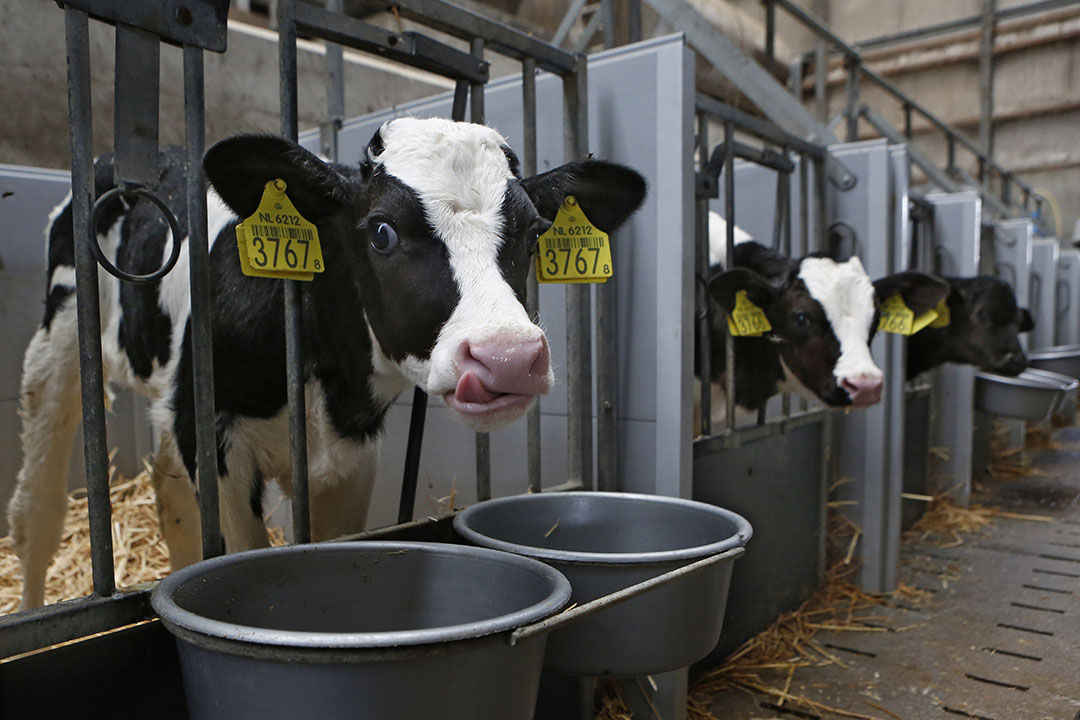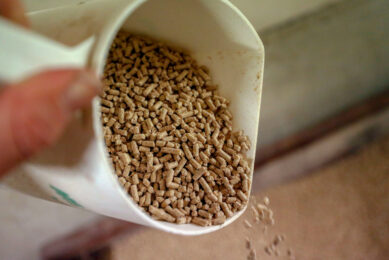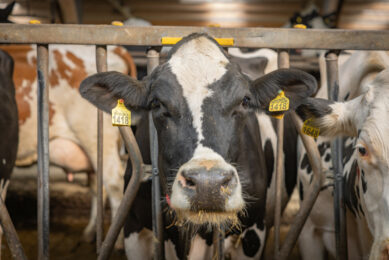Yeast as a direct-fed microbial for neonatal calves

A review of yeast as a direct-fed microbial and the effects that it may have on calf performance.
In most dairy production systems, the greatest proportion of morbidity and mortality occurs among pre-weaned calves. In North America alone, the most recent records of calf morbidity and mortality rates were 34.9 and 6.4%, respectively. More than half of the recorded mortalities were due to enteric infections, which are mainly caused by pathogenic organisms.
Calves predisposed to infection
Enteric infections are detrimental to calf growth and health, and thus have a marked effect on lifelong production and profitability. Neonatal calves may be predisposed to infection due to poor immuno-competence and the prevalence of opportunistic bacteria in the hindgut during the first few weeks of life.
Alternative feed additives
To prevent the risk of infection, producers have commonly administered antibiotics sub-therapeutically to milk replacers and calf starters. However, this practice may not be feasible in the future since antibiotics have been found to create resistant strains of bacteria, many of which are zoonotic and may pose a threat to human health. As a result, there is a movement towards reducing the prophylactic use of antibiotics in South African livestock production. The importance of the gastrointestinal (GI) microflora in the development of the immune system has started to receive more attention. As a result, there is a need to find alternative feed additives that can improve calf growth and health by modifying the resident GI microflora. Direct-fed microbials (DFMs), also referred to as probiotics, may meet this need.

Antibiotic Reduction Special
Moving away from antibiotics can be challenging and requires a new way of thinking. This special edition explores the latest methods for raising healthy livestock without the use of preventive antibiotics.
Direct-fed microbials
A DFM consists of live, naturally occurring micro-organisms that are beneficial to the host when administered in adequate doses. This may include prokaryotic or eukaryotic organisms such as bacteria and yeast. A good DFM should be non-toxic and non-pathogenic, able to tolerate gastric acid, inhibit pathogen growth and enhance the defence mechanisms of the immune system.
Yeasts
Yeasts may be ideal for this purpose because they have the ability to withstand the conditions of the digestive tract (such as a low pH), are resistant to antibiotics, and are significantly larger than bacteria (implying that they can potentially inhibit pathogenic bacteria by stearic hindrance). Various feed additives containing yeast have been frequently used in livestock production.
2 different types of supplements are commonly used:
- An active dry yeast (ADY)
Is produced by drying a yeast biomass to preserve the cells and their metabolic activity, and it usually contains approximately 15 billion colony forming units per gram (CFU/g) of viable fermentable cells.
An ADY is considered to be a probiotic (or a DFM). - A yeast culture (YC)
Contains only a small number of viable cells and it is a fermented product containing a dried culture medium and yeast cell wall components (such as β-glucans and mannanoligosaccharides).
A YC is considered to be a prebiotic.
These 2 terms are often used interchangeably; however, it is important to distinguish between the 2 because they have different modes of action in vivo. Various strains of Saccharomyces cerevisiae (SC) are well accepted as DFMs in the livestock industry. Many have been registered as gut microflora stabilisers in the European Union and accredited in North America by the Generally Recognised As Safe (GRAS) list. To date, they have been predominantly advertised as suitable feed additives for mature ruminants and monogastric animals to improve health and production by preventing subacute ruminal acidosis (SARA) and enteric infections, respectively. Emerging studies may provide evidence that ADYs are also beneficial for young ruminants.

Rumen microbial balance
Feed additives containing SC have been predominantly used in ruminant nutrition to promote a symbiosis of the rumen microflora, which harbours communities of bacteria, fungi and protozoa. However, ruminants are not born with such a complex rumen microflora; instead, the resident microbial community has to be established through a series of profound changes that occur during the pre-weaning phase.
This succession of changes includes the sequential establishment firstly of aerobic bacteria, then anaerobic bacteria and eventually ciliate protozoa. Attaining a stable and diverse rumen microbial community is essential for initiating efficient digestion of dry feed and the absorption of fermentation products. In spite of this, in some production systems young ruminants may be completely weaned from milk before a stable rumen microflora is established. To overcome this, it is proposed that ADYs containing SC may promote earlier maturation of the rumen microflora. This theory is investigated by using germ-free lambs that were reared in a sterile environment (gnotobiotic). All lambs were inoculated with cellulolytic bacteria at specific time points. They found that the group receiving a SC supplement had a more rapidly established and stable community of cellulolytic bacteria present in the rumen within the first 42 days after birth. This was verified by another study in which the effect of SC on microbial colonisation in the rumen of conventional lambs was investigated. It was found that the number of lambs with cellulolytic bacteria present in the rumen at 2 and 4 days after birth was far greater in the SC group than in the control group. Additionally, by 10 days after birth, 60% of the lambs receiving SC had protozoa present in the rumen, whereas protozoa were only first detected two days later in the control group. Ciliate protozoa do not become established in the rumen unless a bacterial population is already present, so the presence of protozoa may be indicative of the stability and maturity of the rumen microflora. SC may promote the growth of highly anaerobic cellulolytic bacteria in the rumen by scavenging oxygen and providing vitamins, amino acids and peptides that stimulate microbial growth. It appears that no research has been conducted to look at the effects of SC on the maturation of the rumen microflora of calves.

However, 2 studies have looked at the effect of SC on calf performance. In one study it was observed that calves receiving SC had improved dry matter intake (DMI) and growth. In the other study there were no observed differences in the growth rate of calves. However, there was a significantly higher DMI in the calves receiving SC. Furthermore, it was found that calves in the group fed SC had higher concentrations of ammonia, propionate and butyrate in the rumen. The study suggests that these results may be influenced by an earlier maturation of rumen microflora, which would subsequently enhance rumen fermentation, improve digestion and promote growth.
Enteric microbial balance
The subspecies S. cerevisiae boulardii (SCB) is more commonly used as an ADY in monogastric nutrition for the purpose of preventing and treating enteric infections. Young ruminants are often regarded as having a digestive tract that is physically and functionally similar to monogastric animals and it is therefore possible that SCB may confer the same health benefits on calves. As a result, most of the emerging studies have focused on the use of this species in calf nutrition. To begin with, in a study it was observed that calves receiving milk replacer supplemented with SCB experienced fewer days with diarrhoea. In addition, it was reported that calves receiving SCB were less likely to experience severe diarrhoea and therefore received fewer antibiotic treatments. It was also found that diarrhoeic calves receiving the SCB supplement managed to maintain the same DMI and growth rate as the non-diarrhoeic calves. Supplementing SCB to the milk replacer may promote symbiosis in the enteric microbial community, which may prevent diarrhoea by inhibiting the growth of pathogenic bacteria and by promoting the development of the immune system. This is of great importance to neonatal calves since they rely on non-specific innate immune responses and attenuating maternal antibodies as a defence mechanism against invading pathogens. In a study it was found that calves receiving SCB had a greater proportion of Lactobacilli (bacteria that promote enteric health) in their faeces. This validates the theory that SCB is able to promote the growth of beneficial micro-organisms in the GI tract. In addition, it was found that the supplementation of SCB influenced colon histomorphology by significantly reducing crypt depth and width. This may have reduced the surface area available for attachment by micro-organisms, thus reducing the risk of pathogen translocation. It has also been found that SCB has an effect on the modulation of the immune system in calves. It was discovered that the defence mechanisms of the innate immune system such as phagocytosis and oxidative burst capacity, which are involved in engulfing and killing pathogens, were enhanced in calves receiving SCB.
Validity of yeast products
Despite the positive results that have been observed in these studies, the benefits of using ADY products are not yet guaranteed in calves. This is due to the fact that some studies have reported no improvements in calf performance when an ADY was administered. Therefore, further research needs to be conducted to understand why some studies can obtain positive results and others not. Some researchers speculate that this may be due to variation in the strain of yeast used, the dosage, the type of yeast product, the diet supplied, the physiological status of the animal and the animal husbandry practices employed. In one study, where Holstein calves received milk replacer supplemented with SCB, the researchers did not observe any improvement in calf growth and health. They reported that all the calves were in good health for the duration of the trial and suggested that an ADY supplement may be more beneficial to a calf when it is exposed to a disease challenge or stress.
Conclusions
Based on the studies mentioned in this review, ADY products containing either SC or SCB have the potential to become recognised as a suitable feed additive for calves. They may improve calf performance by promoting symbiosis of either the rumen or enteric microbial communities. The most recent studies have focused mainly on ADYs containing SCB, showing that it may reduce the incidence and severity of diarrhoea by promoting the growth of beneficial GI microflora and improving the responses of the innate immune system. Despite this, the results obtained are variable between studies and further research is required to understand why there is a disparity. Additional studies should attempt to further investigate the modes of action of ADYs, particularly in calves that are exposed to stress. This may assist nutritionists in establishing clear guidelines for the use of ADYs in calf nutrition.
Author:
Sarah J Davies, Stellenbosch University
Original source: AFMA Matrix March – June 2020 Vol 29 No 1











